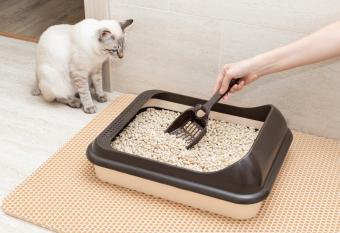
Switching your cat to a new brand or type of litter isn't a quick process, but it's a simple one. Cats are sensitive to change, so an abrupt switch can cause them stress. The best way to switch your cat's litter is to do it gradually; you'll need to mix small amounts of the new litter in with their existing litter over a few weeks. It'll take time and patience, but switching your cat's litter the right way will keep your cat stress-free.
How to Switch a Cat to New Litter (Step-by-Step)
Whether you're using a new brand of cat litter or changing to a different type, such as pine or wood pellets, making the switch is fairly straightforward. It's not a bad thing to swap cat litter, but make sure you're doing it for a good reason, such as being more environmentally friendly or choosing one that is more cost effective. You don't want to switch on a whim and cause extra stress for your cat.
The entire process should take three weeks to complete, though some cats may need more time.
Studies show the average adult cat needs a minimum of 6 days to transition from one litter product to another. However, most cat owners find success by completing it over the course of about three weeks.
Week 1: 1/3 New Litter, 2/3 Old Litter
The first step in the process is filling the litter box with approximately 1/3 new litter and 2/3 of the old type of litter. However, you don't want to just dump the new litter on top; instead, the new litter should go on the bottom. This will allow your cat to still see, smell, and feel the familiar litter when they step into the box, but as they use it and dig around, they'll slowly incorporate the new litter from the bottom up. Leave the box like this for about one week, scooping it daily.
Week 2: 1/2 New Litter, 1/2 Old Litter
A week later, refill the litter box half-full with the new litter type (on the bottom, again), and fill the remaining half with the old type of litter. At this point, your cat has experienced the new litter and is becoming more and more familiar with it.
Scooping the box can become a little tricky now, particularly if you're changing from one vastly different type to another. For example, if you're making the switch from a clumping clay litter to a paper-based litter that does not clump, you'll need to carefully scoop out the soiled paper litter that doesn't clump. It may be necessary to toss all the litter every few days, but make sure you refill with the same 50/50 mixture.
Week 3: 2/3 New Litter, 1/3 Old Litter
At the start of week three, you will continue the transition with the box 2/3 full with the new litter on the bottom and 1/3 of the old type of litter on top. Throughout the process, monitor your cat's behavior and mood. If they urinate outside the litter box, start hiding, or appear stressed, back up a step or start at the beginning. If they continue these concerning behaviors, see your veterinarian.
Week 4: Entirely New Litter
If your cat has done well over the last three steps, it's time to complete the transition with the litter box entirely full of the new cat litter. They should be used to the new litter, so this step shouldn't come as a shock to them. Still, if your cat seems unsure or anxious, back up to step three and top the box with the old litter type. Each cat is different, so go off your cat's body language at each step to gauge whether the switch is successful or if they need a little more time.
Not sure what type of litter your cat should use? Some litter types are safer than others, but all cats have their own preferences.
Tips for Switching Litter With Stubborn Cats

Some cats may be more resistant to a new litter than others. If your cat acts out because of the change and stops using the box altogether or begins spraying around the house, you may need some extra help. Use these tricks for particularly stubborn cats.
- Take more time. Some cats simply need more time than others to adapt to the change. Instead of three weeks, it may take six weeks or longer.
- Try a litter box attractant. These are products you sprinkle onto the litter to encourage your cat to do their business there. It usually isn't a long-term solution, but it can help promote using the new litter and getting your cat used to it.
- Use feline pheromones. Feline pheromones like Feliway can help mellow your cat out during the transition. Plug a diffuser into an outlet near the litter box or give the room a spritz of pheromones every day.
- Set up two boxes. You could consider doing the traditional litter transition with one litter box and setting up another box with your cat's old litter. This will ensure they are using a litter box instead of urinating some place else, like your bed. You can begin to add just a bit of the new litter to the second box and eventually eliminate it altogether.
- Consider a different litter. If your cat refuses to step foot on the new litter, it may be time to try a different type. There are endless brands of cat litter and many varieties, including those made of paper, corn, wheat, or even synthetic litter.
Switch Cat Litters Gradually
No one likes sudden changes, but cats are particularly sensitive to new things in their environment. Slow and steady wins the race when it comes to switching their cat litter. Do it over a period of three weeks or more for the best results. With the right step-by-step method, you can set yourself and your cat up for success.







